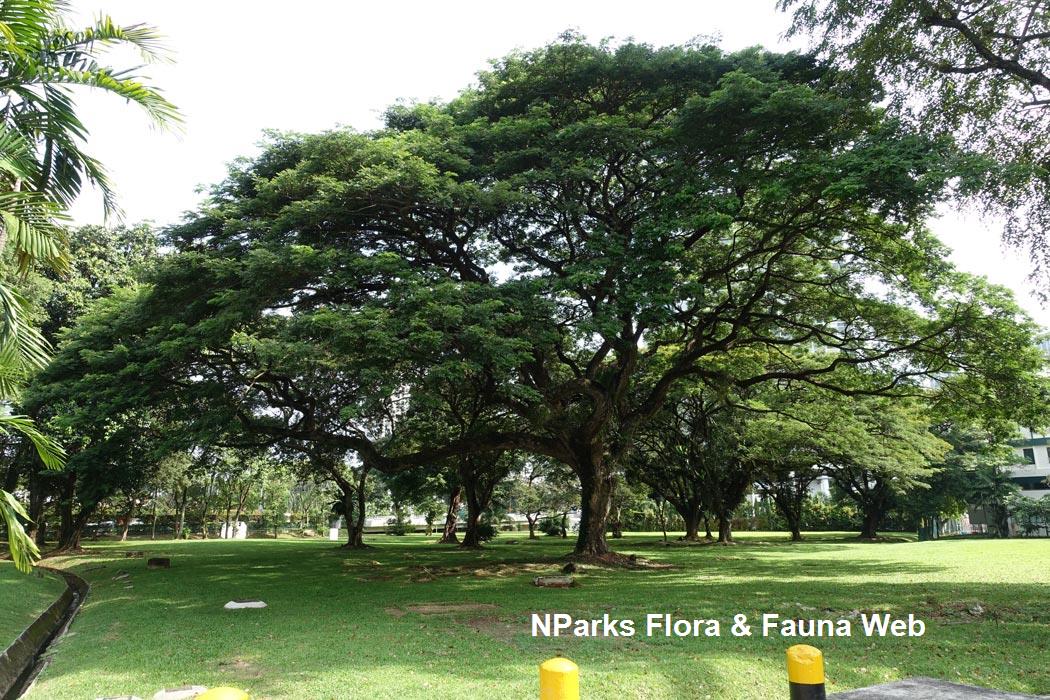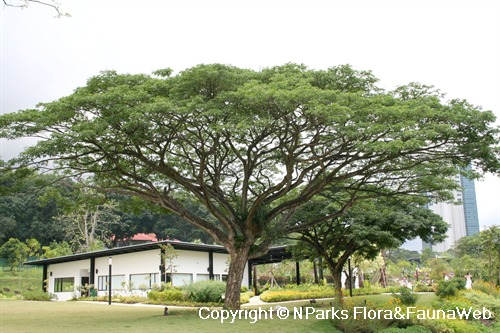_lowres.jpg)
Back
Samanea saman (Jacq.) Merr.
| Family Name: | Fabaceae (Leguminosae) |
| Synonyms: | Albizia saman (Jacq.) F.Muell., Calliandra saman (Jacq.) Griseb., Enterolobium saman (Jacq.) Prain, Feuilleea saman (Jacq.) Kuntze, Inga saman (Jacq.) Willd., Mimosa saman Jacq., Pithecellobium saman (Jacq.) Benth., Zygia saman (Jacq.) A.Lyons |
| Common Name: | Rain Tree, Pukul Lima, Cow Tamarind, Hujan-Hujan, East Indian Walnut, Monkey-pod, Saman, 雨树 |
Samanea saman , also known as Rain Tree, is a tree, up 30 m tall. It is widely cultivated in Southeast Asia, especially Singapore, for its iconic umbrella-shaped crown which provides plenty of shade. The leaflets fold up during overcast days and in the early evening, therefore it is also known as Pukul Lima, which means ‘five o clock’ in Malay.
Name
Classifications and Characteristics
| Plant Division | Angiosperms (Flowering Seed Plants) (Dicotyledon) |
|---|---|
| Plant Growth Form | Tree (Big (>30m), Medium (16m-30m)) |
| Lifespan (in Singapore) | Perennial |
| Mode of Nutrition | Autotrophic |
| Plant Shape | Umbrella |
| Maximum Height | 20 m to 30 m |
| Maximum Plant Spread / Crown Width | 20 m to 30 m |
| Tree or Palm – Trunk Diameter | 4.5 m |
Biogeography
| Native Distribution | Northern tropical South America |
|---|---|
| Native Habitat | Terrestrial (Primary Rainforest, Grassland / Savannah/ Scrubland) |
| Preferred Climate Zone | Tropical |
Description and Ethnobotany
| Growth Form | It is a tree, usually up to 30m tall in cultivation and may reach up to 60m tall in its native range. Its crown is symmetrically umbrella-shaped, wide-spreading (up to 80m across for mature specimens in open spaces) and branching occurs at relatively low height from tree base. |
|---|---|
| Trunk | Dark brown, becoming more fissured with age, and peeling off in long fibrous strips. |
| Foliage | Leaves alternate, bipinnately-compound, with small asymmetrical leaflets that are more curved on outer margin, and finely velvety on underside. Leaflets fold up in early evening and during overcast days. Partially deciduous under local conditions. |
| Flowers | Produced as dense powderpuff cluster with numerous filamentous stamens, pink above and white below, slightly fragrant, attractive to bees. |
| Fruit | Loment seedpods, fairly straight, fleshy with thickened edges and constricted in between seeds, ripening to black and breaking apart into segments along constrictions. Contain numerous dark brown seeds embedded in sticky, sweet-smelling, brownish-black pulp. Thought to be previously dispersed by now-extinct Pleistocene mammals, seeds now eaten and dispersed by cattle and other vertebrates, or by natural disintegration of the pods on the ground. |
| Habitat | It is found in dry forests and savannahs of tropical Americas and widely introduced as a landscape tree in tropical Southeast Asia and Hawaii. |
| Cultivation | It is a hardy tree which is tolerant of poor acidic soils down to pH 4.6, and waterlogged conditions. Recommended planting distance is 18m along roadsides and 24m in open spaces. Trees located very closely together under plantation conditions produce fewer branches and longer clear trunk suitable for timber use. Relatively pest-free, although many specimens in Singapore have experienced die-back and defoliation due to attack by a Phomopsis fungal complex that is promoted by drought stress.Easily propagated by stump and stem cuttings, and by seeds (pretreat by soaking in hot water for 3 minutes, followed by 24 hours of cold water). Seed progenies can be somewhat variable, Based on local nursery experience in batch-sowing (of seeds from several mother plants), it is observed that 80%-100% of the seedlings would be the normal green form, 0%-20% would be the yellow form, 0%-10% would be the green small leaf form (with leaflets half the size of that of the normal green form), while the remaining 0%-5% may consist of a more peculiar "clingy" variant with leaflets that are held closely to the twigs and thus appear folded up. |
| Etymology | Genus epithet 'Samanea and species epithet 'saman' derived from linguistic corruption of the tree's' vernacular Spanish name in northern Venezuela, "zaman" (meaning "Mimosa-like tree"). Common name 'Rain Tree' alludes to tree's habit of folding up leaves before rain, or to the shower of secretions from sap-sucking Cicadas resting on tree. |
| Ethnobotanical Uses | Edible Plant Parts : Edible Fruits Food (Herb or Spice) Cultural / Religious: Heritage Tree: There are 35 individuals of Samanea saman listed as Heritage Trees in Singapore. They are found all over various parts of Singapore. To find out more about these trees, please visit the Heritage Tree Register. Others: Medicinal: Seeds chewed to relieve sore throat. Infusion of fresh leaves and inner bark drank as tea to treat diarrhoea. Bark or root decoction used in hot baths to treat stomach cancer. Leaf extract reported to have inhibiting effect on Mycobacterium tuberculosis -- the causative bacterium for many types of tuberculosis. Food: Sticky, sweet, liquorice-flavoured pulp from seed pods eaten raw by children, or made into lemon-like beverage. Timber: Tree valued for durable timber. Sawn wood shrinks very little during drying, allowing it to be worked on even when unseasoned. The preferred wood used for carvings (eg. traditional Hawaiian tikis), crafts, furniture, panelling and boat-building. Trunk sections used to make oxcart wheels in Central America. Also used as high-quality firewood and charcoal, as well as to make paper. Products: Grounded up seedpods used as raw material for making biofuels, or shaped into balls and dried in the sun to obtain very hard cricket-ball substitutes used as toys by children in Southern India. In Thailand, tree is used as primary host plant for Laccifer lacca (Lac Insect) that feeds on resin-rich bark of tree, and coat colonized branches with a reddish resinous pigment, which can be harvested as a rather poor-quality and brittle seedlac, or further processed into shellac. Also yields an inferior gum used as substitute for gum arabic. Seeds dried and made into necklaces or other craft items. Agriculture: Nutritious seedpods used as fodder for livestock. Trees used in plantations to provide shade for crops like coffee, tea, cocoa, nutmeg and vanilla. Also used in pastures to provide shade for grazing animals. Nitrogen-rich prunings used as green manure to improve soil on agricultural and pastoral lands. Culture: According to legend, Venezuelan political leader and army general Simón Bolívar (1783-1830), known for leading 5 Latin American countries (Venezuela, Colombia, Peru, Ecuador, Bolivia) to independence from Spanish monarchy rule, was said to have camped his entire liberation army near Maracay (a city in central Venezuela) under a very large Albizia saman tree, now popularly known by the locals as "saman de guerra" -- meaning "saman of war" in Spanish-Portuguese. |
Landscaping Features
| Desirable Plant Features | Ornamental Flowers |
|---|---|
| Landscape Uses | Suitable for Roadsides, General, Shade Providing Tree / Palm |
| Thematic Landscaping | Naturalistic Garden |
Fauna, Pollination and Dispersal
| Pollination Method(s) | Biotic (Fauna) (Insects (Bee)) |
|---|---|
| Seed or Spore Dispersal | Biotic (Fauna) (Dispersed by livestock (cattle, goats, hogs) and wild animals in native range. ) |
Plant Care and Propagation
| Light Preference | Full Sun |
|---|---|
| Water Preference | Moderate Water |
| Plant Growth Rate | Moderate |
| Rootzone Tolerance | Fertile Loamy Soils, Waterlogged Soils (Drains Site) |
| Diseases | Prone to twig dieback due to infection by Phomopsis sp. Prune back dead branches to healthy parts, and fertilize plant well. |
| Propagation Method | Seed, Stem Cutting, Root Cutting |
| Propagule Establishment Remarks | Scarified seeds germinate in 3-5 days, ready for planting out in 3-5 months. Cuttings and young specimens easily transplanted. |
| Maintenance Requirements Remarks | Flower and fruit may cause litter problem. |
| Propagation Method Remarks | Collect seeds from fallen pods (seeds become viable only shortly before pods drop from tree). |
| Planting Distance | 18 to 24 |
Foliar
| Foliage Retention | Evergreen |
|---|---|
| Mature Foliage Colour(s) | Green |
| Mature Foliage Texture(s) | Smooth, Velvety / Furry / Tomentose |
| Foliar Type | Compound (Bipinnate) |
| Foliar Arrangement Along Stem | Alternate |
| Foliar Shape(s) | Non-Palm Foliage (Oval, Asymmetrical) |
| Foliar Venation | Pinnate / Net |
| Foliar Margin | Entire |
| Typical Foliar Area | Microphyll ( 2.25cm2 - 20.25 cm2 ) |
| Leaf Area Index (LAI) for Green Plot Ratio | 2.5 (Tree - Open Canopy) |
Non - Foliar and Storage
| Trunk Type (Non Palm) | Woody |
|---|---|
| Bark Colour(s) | Dark brown |
| Mature Bark Texture | Fissured |
| Stem Type & Modification | Woody |
| Root Type | Underground (Tap Root, Fibrous Root) |
Floral (Angiosperm)
| Flower & Plant Sexuality | Bisexual Flowers |
| Flower Colour(s) | Pink, White |
|---|---|
| Flower Size - Remarks | Small, massed in clusters |
| Inflorescence Type | Head / Capitulum |
| Flowering Period | Free-Flowering |
| Flowering Opening Time | Time-Independent |
| Flowering Habit | Polycarpic |
Fruit, Seed and Spore
| Mature Fruit Colour(s) | Black, Brown |
|---|---|
| Fruit Classification | Simple Fruit |
| Fruit Type | Dehiscent Dry Fruit , Lomentum / Loment |
Image Repository
Others
| Master ID | 1813 |
|---|---|
| Species ID | 3106 |
| Flora Disclaimer | The information in this website has been compiled from reliable sources, such as reference works on medicinal plants. It is not a substitute for medical advice or treatment and NParks does not purport to provide any medical advice. Readers should always consult his/her physician before using or consuming a plant for medicinal purposes. |
















_lowres.jpg)
_lowres.jpg)
_lowres.jpg)
